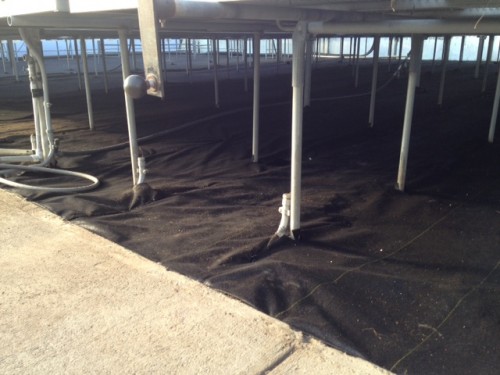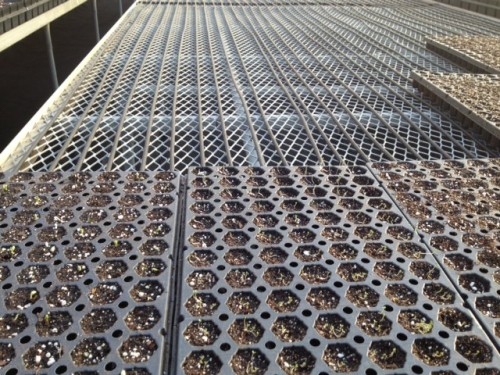by Kenan White | Apr 10, 2013 | Life on the Farm |
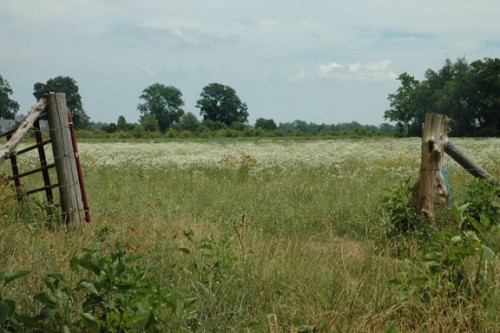
I’ve never actually taken the time to add things up, but I think it’s probably safe to say that over the course of my career, I’ve grown 3 million plants. They’re all for you.
Oh, sure, it sounds impressive, but it’s really a labor of love. It’s what I love doing, and I simply can’t imagine doing anything else. For some people, gardening is a hobby on the side. For me, it’s a way of life.
The truth is, though, I haven’t just been growing plants for you during all of this time. I’ve also been growing and harvesting fruits, vegetables, and ornamentals for my own personal use and consumption.
It goes a bit further than that, though, and lest I risk the nickname “Johnny Appleseed,” I’ve actually been sowing millions of seeds on almost any patch of ground I can find. After all, I’ve had 800 acres to fill for years. It’s a bit tough to tell exactly how many plants I’ve fathered.
I planted 50 acres to help encourage wildlife reproduction of all kinds. Letting plants grow without interference means offering birds, small mammals, and other wildlife the chance to get food for themselves and nurture entire families. It’s literally the chance to build a self-sufficient ecosystem, a chance few people actually take advantage of.
I’ve also replanted former crop land with warm season grasses like prairie grasses and wildflowers, creating beauty where there was once only a clearing.
I’ve already told you that part of the reason behind this planting frenzy is that it’s just who I am, but it’s probably more than that. My plants mean that we have healthier soil and more bountiful wildlife. It means that we have the native pollinators we need to replace the dying honeybees.
We’ve even gone so far as to be part of the CRP program, a federal program that helps farmers use environmentally sensitive land for the benefit of conservation. In fact, we were the first to be 100% compliant with the Chesapeake Bay Act. We took poor cropland out of production and replanted it as a buffer to the James River.
When you take the time to make your next order, it’s fine to imagine me as Johnny Appleseed. I’m endlessly collecting and planting seed all over the farm, and I guess I always will be.
by Kenan White | Apr 3, 2013 | Herbs |
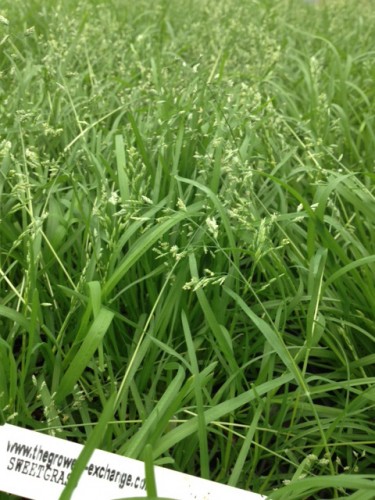
Sweet grass has long been considered a sacred plant for a variety of different cultures. One whiff of this aromatic beauty, and you’re certain to know why. It has a distinctive scent that you’ll never forget. It’s a fairly hardy perennial, and it’s as native to North America as it is to Europe. It reaches just 20 cm in height at its peak, but the leaves can stretch outward for quite a ways by the end of the growing season.
Traditional uses abound for this amazing plant. It was often used as incense, tea flavoring, a kind of tobacco, and even perfume. It was, and is, also used for basket making.
As phenomenal as it is, it’s actually harder than you may think to grow. Unless you already have a plant established, it can be fairly difficult to get some started in your yard. Only a fresh seed will actually germinate with this plant. I learned that bit the hard way. I purchased seeds for nearly two years straight, and they were almost always dead. I simply couldn’t get it to grow through a store-bought seed. The only way I could really get it going was by dividing my plants. It seems to take really well to that.
One year, I decided to try something a bit different – fresh seeds. I created an open flat of soil right next to my plants, then started splitting them open right over the soil. In what seems like mere minutes in my memory, I had created a new sweet grass plant.
Sweet grass has long had a close association with people, which is probably one reason why viable seeds are so hard to get these days. Like garlic and horseradish, humans tend to replant it everywhere, and nature has a way of knowing when to scale back on viable seed production.
There are few things quite as rewarding as sweet grass, though, so spend a bit of time experimenting with this very traditional plant on your own this season.
by Kenan White | Mar 27, 2013 | Herbs |
The red basil is letting me down this year. We’ve grown it successfully for three seasons, but it just doesn’t seem to be coming together this year.
If you know anything about red basil, it’s a fairly slow growing herb. Originally a native of tropical Asia, it offers a strong, warm flavor and added freshness to almost any dish. It also offers a serious nutritional punch because it’s packed with antioxidants, calcium, fiber, Vitamin A, and more. You’ll find many recipes using red basil in Thai cooking, but it’s much more than a cooking herb.
Red basil is nothing short of beautiful. In fact, throughout the US, it’s known primarily as an ornamental. With a strong flavor and scent, it’s the perfect addition to any garden, and there is some evidence that even suggests it works as a mosquito repellant.
As amazing as this little plant is, though, we’re having a hard time finding live, viable seeds anywhere. A quick search will reveal that this doesn’t seem to be its year throughout the U.S.
What’s happening to the red basil?
For more than three seasons, we’ve grown our own plants, harvested our own seeds, and this year, we barely hit fifty plants from the entire crop. As a gardener who build a business on a great set of green thumbs, I am at a loss for words with this one. The seeds simply won’t germinate.
Every cloud has a silver lining, though. The problem has not transferred itself to the green holy basil, so if your goal is simply basil this year, that’s stocked and ready to ship.
I’ll be doing some heavy research on this topic this summer, so stick with us for updates to the red basil conundrum.
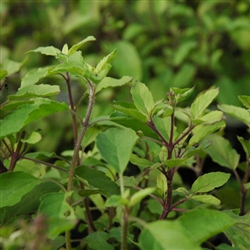
by Kenan White | Mar 22, 2013 | Herbs |
It’s official – Spring is finally here! Well, sort of. For many across the country, it may feel as if spring is never going to arrive. Here in Richmond, the chill is slowly beginning to recede, but we’re still expected to have temperatures in the forties over the course of the next week. New England got another 15 inches of snow earlier in the week, and our friends in the Midwest are expecting snow off and on through the end of the weekend.
Rest assured, though, spring is on its way, and our full crop of gorgeous herbs are absolutely ready to ship. Like you, we’re just waiting on the warm weather to start cooperating because these perfect varieties are at their peak now and ready for transplant.
Take a quick peek at a few of our stars:
Tarragon – Look at these gorgeous tarragon plants? The star of fresh herbs, if you do any cooking at all, this one has to be part of your herb garden. It has culinary powers few others do, and traditionally, we’ve heard about all sorts of cures made from this wonderful plant. From curing stomachaches to colic in little ones, it may still hold sway that we don’t understand. The trick with growing it, though, is to be careful with the moisture in your soil. It tends to grow better in a dry environment.
Lavender – Known for a combination of fragrance and beauty, there are lots of reasons to add this one to your garden. It’s been used as an antiseptic for years, and it can help with those irritating insect bites warmer weather so often brings use here in Richmond. It’s also a great insect repellant, and the scent is nothing less than divine.
Citronella – Speaking of insect repellent, this is we think you should certainly consider. It’s strongly-lemon scented leaves are perfect for keeping the mosquitoes away, and it’s the perfect patio plant if you’re running out of space. What’s more, though, is that this one is drought-tolerant, which is great for those who had such a dry summer last year.
We’re ready to ship as soon as you are. Drop by our virtual nursery now and starting planning your herb garden.

by Kenan White | Jan 24, 2013 | Gardening, Growing, Herbs, Life on the Farm, Seeds |
The Delta-T heating system we purchased will deliver heat where it matters most to plant development, the root zone. Everyone knows that a healthy plant must have a healthy root system. To insure all Growers Exchange herb plants fill their pot with vigorous roots, we will keep soil temperatures at 65 degrees to stimulate rapid root development.
To keep the green plant tops from growing too quickly, the air temperature in the greenhouse will be at 50 degrees at night. Growth is slower at cooler temperatures so the stems are thicker and stronger. The stem length between nodes is shortened, creating a symmetrical plant.
Bottom heat will also allow us to propagate more plants from cuttings. Many herbs like rosemary, lavender, and mint are best increased by vegetative propagation, also known as cloning. A mist system keeps the non-rooted plant stems hydrated until the warm soil promotes root growth. In about a month a new plant is ready to be re-potted.
Tropical herb plants like Lemon Verbena, Lemon Grass, Vietnamese Coriander, Dill, and Basil will also benefit from the new bottom heat. Try as we do, some days we can only keep the greenhouse but so warm. Wood fired space heaters warm the greenhouse air; but some winter days only so much heat is possible. We could also consider stone flooring that promotes underfloor heating and is able to retain heat well, allowing the plants to stay warm even when it’s cold outside. The bottom heat system, however, will act as a great attachment to the other options ensuring that our plants stay in their optimal temperature zones. Now we will be able to keep the root zone of these tropical herbs at their desired 65 degrees no matter what is happening outside.
As greenhouse growers, this new bottom heat is as exciting as Christmas! We will have plenty of herb plants ready for spring planting. The bottom heat helps the seedlings prepare for Spring. Winter is the best time to plan your herb garden. Don’t forget to order early, many herb plants are grown in limited quantity. And a tip from a greenhouse grower: have plants sent as early as your planting zone allows.
